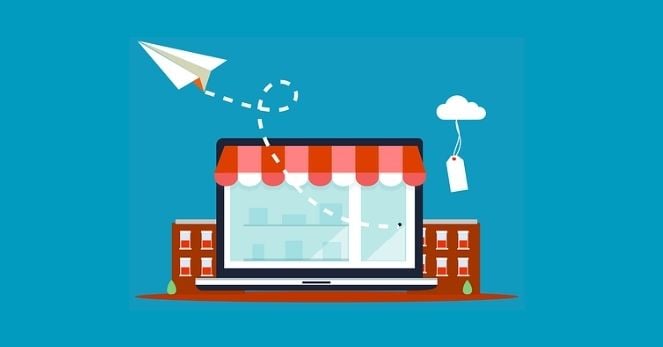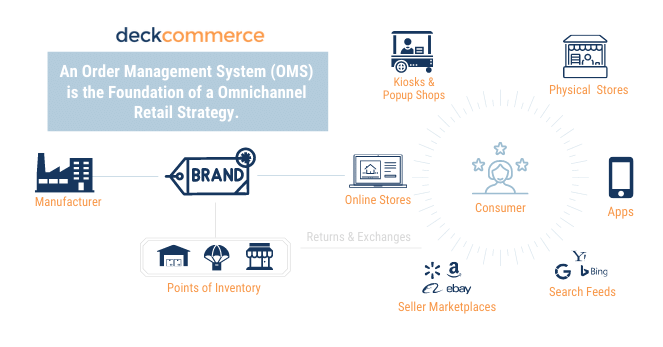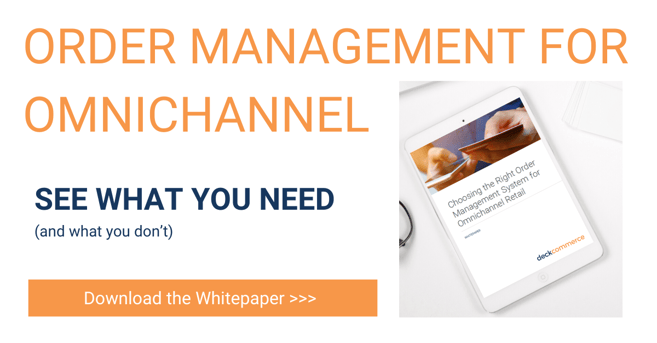What is an Order Management System? Your Retail Order Management Guide

As buying behaviors continue to shift, the lines between in-store and online shopping have become blurred. Consumers expect to have the same buying experience with your brand—whether they are scrolling on their phone or strolling through your store. Retailers need the capabilities to meet these expectations to continue to grow.
That's where retail order management systems (OMS) come in.
OMS systems tie your commerce tools and customer experience together. In this article, you'll learn what every retailer needs to know about order management systems and how to determine the right solution for your brand.
- What is Order Management?
- Why is Order Management Important?
- Why do Retailers Need Order Management?
- Benefits of an Order Management System in Retail
- Options for Order Management
- Must-Have Features and Capabilities for OMS in Retail
- How to Determine the Right OMS Solution for Your Retail Brand
What is Order Management?
Order management is the facilitation of all retail order data and processes—from storefront to front door. It automates the receiving, routing, fulfilling, tracking, notifying, (and potentially returning/exchanging) of orders.
Simply put, order management overarches everything from when a customer browses your website (or store) — to the time they receive the order— and unifies touchpoints that compose seamless shopping experiences.
What makes a modern order management system (OMS) unique is its ability to zoom out to see the big picture of the retail business—beyond warehouses, inventory visibillity, and channels—and give brands the ability to map out their desired customer journey.
Powerful order management brings all retail channels together and empowers brands to connect with customers exactly where and when they want to buy—whether click, cart, or curbside.
Why is Order Management Important?
Two of the most important aspects of any retail business are:
- Your customers
- Your product
Because order management involves how customers purchase and receive your products— it is a key driver behind your brand experience. And given that almost half of consumers won’t buy from a brand again if they have a poor experience—order management is vital to customer acquisition and retention.
Order management is vital to customer acquisition and retention.
Order management system software also empowers omnichannel retail. Since omnichannel shoppers have a 30% higher lifetime value than those who shop using only one channel (Google), then your order management system acts as a growth engine for your retail brand.
Why Do Retailers Need Order Management?
In 2019, retail sales from physical stores accounted for 84% of total retail sales in the U.S. (Digital Commerce 360). Amidst a global pandemic and the closing of brick-and-mortar stores, the retail industry took a huge hit in 2020.
However, brands with a strong omnichannel backbone in place survived (or even thrived) over brands that were slow to transform digitally.
An order management system helps pain points:
Customer Pain Points Order Management Software Solves
- A customer wishes to change / cancel an order shortly after placing it (order grace periods)
- A customer received a damaged item, but the nearest warehouse is out of stock (replacements from alternative inventory points)
- A customer buys a product online, but wishes to return it in person (BORIS)
- A customer purchases an online-only product, but wants picks it up in person (BOPIS)
- A customer is in-store but the item they want is out of stock at that location (endless aisle)
- A customer wants visibility into their order without contacting customer service
- A customer wants full order lifecycle support (including returns, appeasements, etc.)
Retailer Pain Points OMS Solves
- Build a "future proof" tech stack
- Expanding into new channels (marketplaces, global expansion, new consumer experiences etc.)
- Leverage a system-agnostic OMS to easy add or scale new technology systems
- Real-time order processing times via automation and prebuilt workflows
- Flagging suspicious orders to minimize risk of fraudulent orders
- Streamline personalized products that require manual review (flags and alerts)
- Prevent customer service agents from having to sign into multiple systems (CRM, ERP, WMS, Payment tool, Fraud vendor, etc.) to locate and service an order
- Cutting down call volume to store associates asking about inventory levels
- You need to simplify communication between your front-end and back-end systems
Each of these interactions can be headaches for retailers and customers alike, but an order management system empowers brands to unify their systems, channels, and operations to create smoother customer experiences with less hiccups.

Benefits of an Order Management System
Control of Your CX
It is critical for retailers to create their customer experience with creativity and precision. A modern OMS gives you control of the complete order lifecycle so that you can curate the best possible customer experience. Your customer experience can be the differentiator between a one-time customer, and a lifetime customer.
Reduced Fulfillment Costs
Distributed order management (DOM) aggregates inventory across your distribution network, so you can fulfill orders in the most efficient, cost-effective way possible. A high-performance order management solution should include DOM capabilities— where you can configure and design order routing, logic, and complex workflows to help you ship from the closest inventory point— ensuring your customers receive their shipments faster and cheaper.
Increased Visibility
The order lifecycle spans from order receipt through final-mile fulfillment. While retail brands may have disparate systems through the buyer experience, (i.e. storefront, ERP, POS, WMS, TMS, etc.) an OMS overarches and unifies all of the systems and serves as the single source of truth for orders. OMS will give retailers access to all the order information and history your finance, fulfillment, IT, and customer service teams need at the various points of the order lifecycle.
Higher Inventory Accuracy
A modern OMS provides available-to-sell inventory levels so you know exactly where you can fulfill orders (online, ship from store, etc.) and avoid stock-outs and unplanned backorders.
Advanced Order Fulfillment Capabilities
As consumer buying habits become more interwoven and complex, so does a retailer’s need to offer advanced order fulfillment processes. For example, a shopper may browse your website, visit your store, and download your app before they decide to buy. If they see something they want to buy but you don’t have the capability to fulfill it in the channel they happen to be in— they may go to your competitor instead.
If you have “gaps” in meeting your customer expectations, you should consider leveraging an order management system to close gaps other technologies may have. Some advanced customer interactions include the following capabilities:
- Curbside pickup
- Buy online pickup in store (BOPIS)
- Buy online return in store (BORIS)
- Ship from store / store fulfillment
- Preorders / backorders
- Delayed payment capture
- Loyalty programs
- Subscription boxes / Recurring orders
- Customized products that require manual review
- Potentially fraudulent orders that require manual review
- Multiple payment types (Apple Pay, Venmo, PayPal, etc.)
- Refund, replace, repair, refurb, or recycle returned items
- Unique product compliance (alcohol, firearms, etc.)
If you have “gaps” in meeting your customer expectations, consider leveraging an order management system.
Offering advanced order fulfillment gives you the peace of mind knowing that you have the ability (no matter how complex) to get your product into the hands of your customers.
Automation of Laborious Tasks
Without an order management system, many orders require manual processes and can be cumbersome. These tasks can lead to your associates spending more time focused on processes rather than people (i.e. your customers!). With OMS you can automate complex, or time-consuming tasks such as:
- Order routing
- Returns / exchanges
- Complex order workflows
- Order flagging / manual review
- Consumer communications
- Bulk order status updates
- Exception management
- Unique payment capture (channel, complete order, etc.)
- Financial reporting
Case Study: See how a wellness retailer automated 94% of order management processes.
Automating once-manual tasks and processes makes life easier for everyone— but especially your customer service team.
Options for Order Management
OMS systems are not "one size fits all," so it is important to assess your retail business before deciding what option would be best.
| Option | Pros | Cons |
| Leverage Your ERP |
|
|
| Leveraging your Storefront Software Suite |
|
|
| Build an OMS In house |
|
|
| Order Management System (OMS) |
|
|
Must-Have Features & Capabilities for Retail Order Management Solutions
Not all order management solutions are created equal. So how do retailers find the solution that works best for their brand?
Consider the following capabilities “must haves” for your order management system:
- Order aggregation - The ability to aggregate all your orders across channels, including digital storefronts, online marketplaces, endless aisle applications, and POS systems.
- Global visibility - The ability to monitor and manage all orders in one centralized location.
- Full order lifecycle management - Visibility and management capabilities that span the entire order lifecycle, from the time an order is placed to the appeasements, returns and exchange process. This includes, for example, advanced automation rules for order processing and return management that allow for buy anywhere/return anywhere capabilities.
- Omnichannel fulfillment orchestration - The ability to fulfill an order from anywhere. Look for a solution that can automate and optimize fulfillment operations while taking into consideration multi-point distribution criteria.
- A friendly customer service portal - A centralized location that gives customer service representatives full visibility into every order. The solution should also provide access to tools representatives can use to modify existing orders, provide appeasements, handle refunds and exchanges, and reship if needed.
How to Determine the Right OMS System for Your Retail Brand
Understand Your Goals & Objectives
First and foremost, outline all of your commerce requirements and what you need OMS to accomplish for your brand. Are you a traditional retailer moving to direct to consumer? How “omni-minded” is your supply chain?
Read More→ What to Consider When Choosing a Software Vendor for your Ecommerce Business
Assess the Complexity of your Business
Think about the various factors that determine the complexity of your fulfillment chain. Perhaps consider the following key factors:
- Distribution network (# of warehouses, drop shippers, etc.)
- Average annual order volume
- Order complexity / workflows (flagging, customizations, etc.)
- Product nuances (compliance)
- Needed integrations (payment provider, customer loyalty, etc.)
Partner with a Like-Minded Provider
Possibly the most important aspect of determining the right solution, is finding the right partner to help you accomplish your business goals. These types of providers often look beyond contracts—and become an extension of your commerce team.
Consider Price Vs. Cost
The cost of order management can vary greatly. First there is the initial "price," and then there is the long-term cost (and potentially opportunity cost) of the approach you select.
"Tack on" capabilities to larger systems (i.e. ERPs, storefronts software suites) are often cheaper to implement initially as you are likely offered bundled pricing from their flagship applications. If you are a small-volume retailer with a less complex distribution network, a tack-on approach might be sufficient for your requirements.
However, if you are a high-volume, D2C retailer or have fairly complex fulfillment operations— leveraging a high-performance OMS solution will most likely prove to be more cost-effective in the long run.
Why? Because many D2C brands find that implementing a tool that offers them what they need right now, is often not the full order management solution they need for their future tech stack. Morphing a tack-on tool into what your brand needs is costly, both in time and money.
Industry-Leading Retail Order Management Solutions
Order management is more than a buzzword in commerce— it is the thread that unifies your commerce tools and hems your customer experience together. As consumer habits continue to shift, OMS now offers retailers the capabilities and visibility they need to craft the best possible customer experience.
